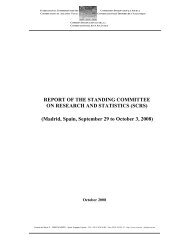E - Iccat
E - Iccat
E - Iccat
You also want an ePaper? Increase the reach of your titles
YUMPU automatically turns print PDFs into web optimized ePapers that Google loves.
ICCAT REPORT 2012-2013 (I)<br />
Some catch statistics are uncertain, i.e., significant catches of bigeye, yellowfin and skipjack, as well as other<br />
species are landed in West Africa and sold as faux poisson. Monitoring should be improved as important catches<br />
might not be reported (faux poisson). This also concerns the bigeye catches taken by purse seiners (estimated<br />
from Japan’s import statistics), as these estimations are uncertain. The estimates of unreported catches of some<br />
purse seiners are very important. They have increased since 2006 and could exceed 20,000 t per year for the<br />
three major species.<br />
As regards the “faux poisson” landed at the Abidjan market, the average is 6,641 t from 1998 to 2007. The<br />
Committee includes these estimates in the reported historical catches of EU-purse seiners since 1981, as well as<br />
in the catch-at-size matrices. However, new estimates indicate record levels amounting to around 11,000 t per<br />
year between 2005 and 2010 for the overall purse seine fleets operating in the East Atlantic.<br />
The catches of one purse seiner component of the fleet transhipped at sea before 2011 were excluded from the<br />
processing of the fishing statistics. The unreported catches of a part of the fleet provide detailed information.<br />
However, an important part of some purse seiners was evaluated by comparing the landings in West African<br />
ports and the data from the canneries reported to ICCAT. Estimates of these unreported catches have increased<br />
and the Committee has expressed the need for the countries and the industries concerned to improve the<br />
collection of the data. The preliminary results of the recent mission of experts in Ghana, under the auspices of<br />
ICCAT, suggest the existence of bias in the sampling protocol aimed at correcting the multi-species composition<br />
of the catches recorded in logbooks. This process is still on-going. The estimates have not been incorporated in<br />
the assessments and are not included in the estimates of reported catches. However, their magnitude is likely to<br />
influence the assessment of the state of the stock.<br />
There are also some uncertainties in the biological parameters: natural mortality, growth, stock structure and<br />
movements. A tagging program should be encouraged to resolve these uncertainties by providing comparative<br />
biological results, movement patterns and a possible stock structure, as well as an analysis of interactions<br />
between fleets, data on the effects of FADs on tuna resources, an assessment of the management measures (i.e.:<br />
the effect of the closures). Tagging programmes that are carried out correctly provide useful information to<br />
respond to the most important question: the size of the population.<br />
Dr. Santiago noted that Dr. Alain Fonteneau (European Union) gave a presentation at midday on November 14<br />
describing results from the IOTC tagging program in the Indian Ocean and the need for a similar program in the<br />
Atlantic Ocean.<br />
The Atlantic provides 6% of the worldwide production of skipjack tuna (last assessment carried out in 2008).<br />
These catches are carried out mainly by purse seiners and baitboats. Catches in 2011 were very high both in the<br />
East and West Atlantic: 173,338 t, i.e. an average 34% increase compared to the 2006-2010 average. It is<br />
unlikely that the eastern stock is overexploited and in the West Atlantic the catches are higher than the current<br />
replacement yield.<br />
There is no specific recommendation in force for skipjack tuna. Although average catches in recent years are<br />
below the MSY, the Committee is concerned about the high level of catches in 2011 on both sides of the Atlantic<br />
and the recent potential underreporting in the East Atlantic. Recommendation 11-01, which will enter into force<br />
in 2013, should have an impact on skipjack catches. The SCRS estimates that catches should not exceed the<br />
MSY. The Commission should be aware that the increase of skipjack catches and fishing effort could have<br />
involuntary consequences on other species caught in association with skipjack in some fisheries.<br />
For bigeye tuna (last assessment conducted in 2010), 18% of the worldwide production is taken from the<br />
Atlantic. Catches carried out by purse seiners, baitboats and longliners reached 77,000 t in 2011 (the average<br />
catches for 2006-2010 amounted to 75,000 t). The historical peak of 1994 reached 133,000 t followed by<br />
declines in catch related to the reduction in fishing fleet size (longliners), as well as the decrease in fishing effort<br />
(longliners and baitboats). The number of active purse seiners declined by more than half from 1994 to 2006, yet<br />
experienced an increase since 2007 (piracy in the Indian Ocean and the presence of other fleets).<br />
The average weight of bigeye tuna caught in free schools is significantly higher than bigeye tuna caught under<br />
FADs, and these differences are more marked throughout the last four years.<br />
There is considerable uncertainty as regards the stock status and the projections for bigeye tuna. 52% of model<br />
outcomes considering uncertainties indicated that bigeye tuna stock status in 2009 was consistent with the<br />
Convention objectives. The 2011 catches of bigeye tuna (77,513 t) are less than the corresponding TAC.<br />
232

















